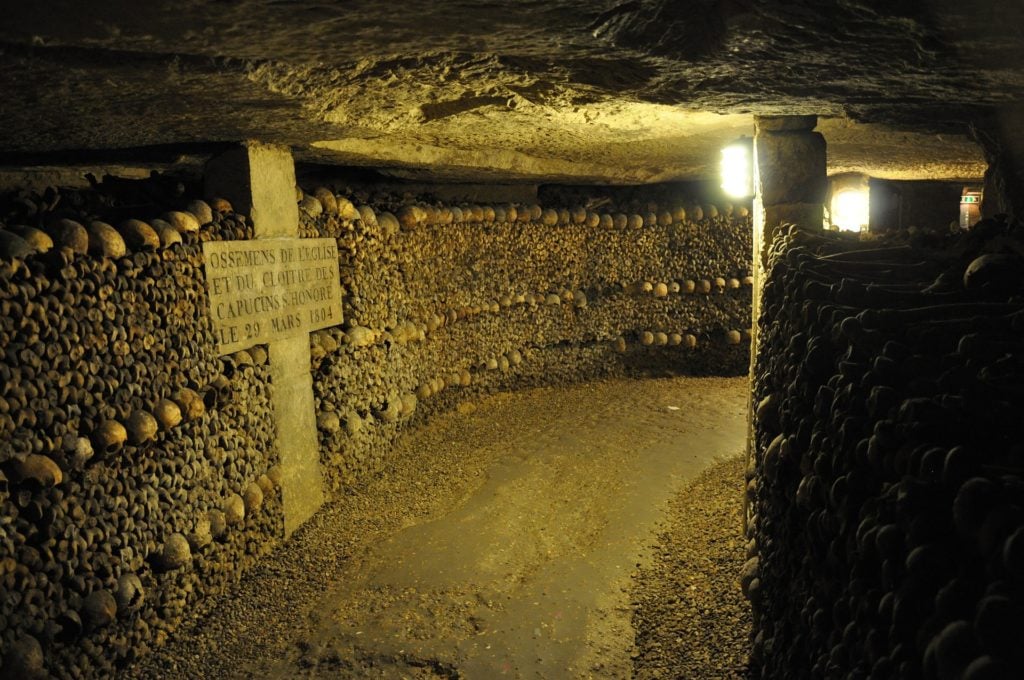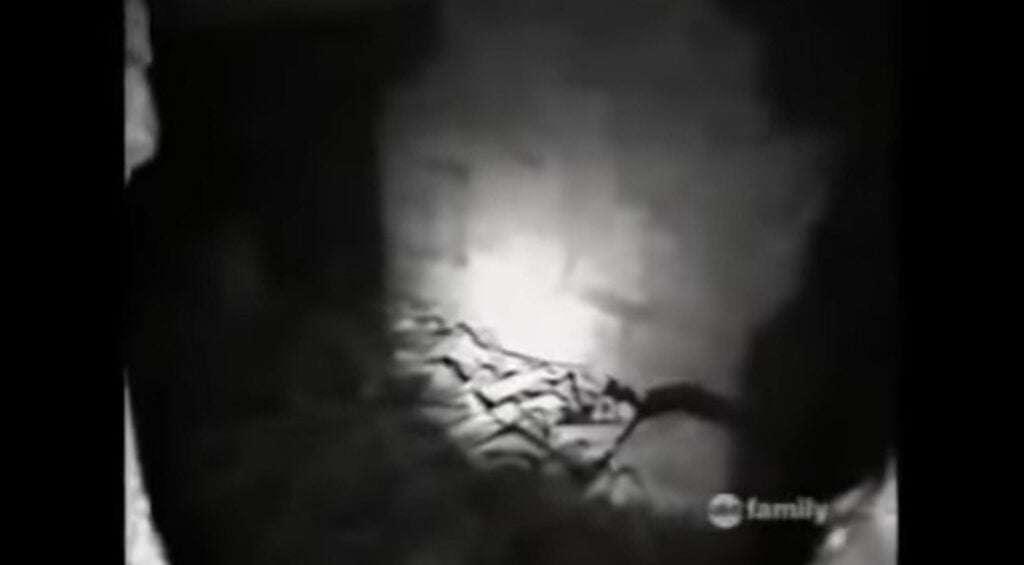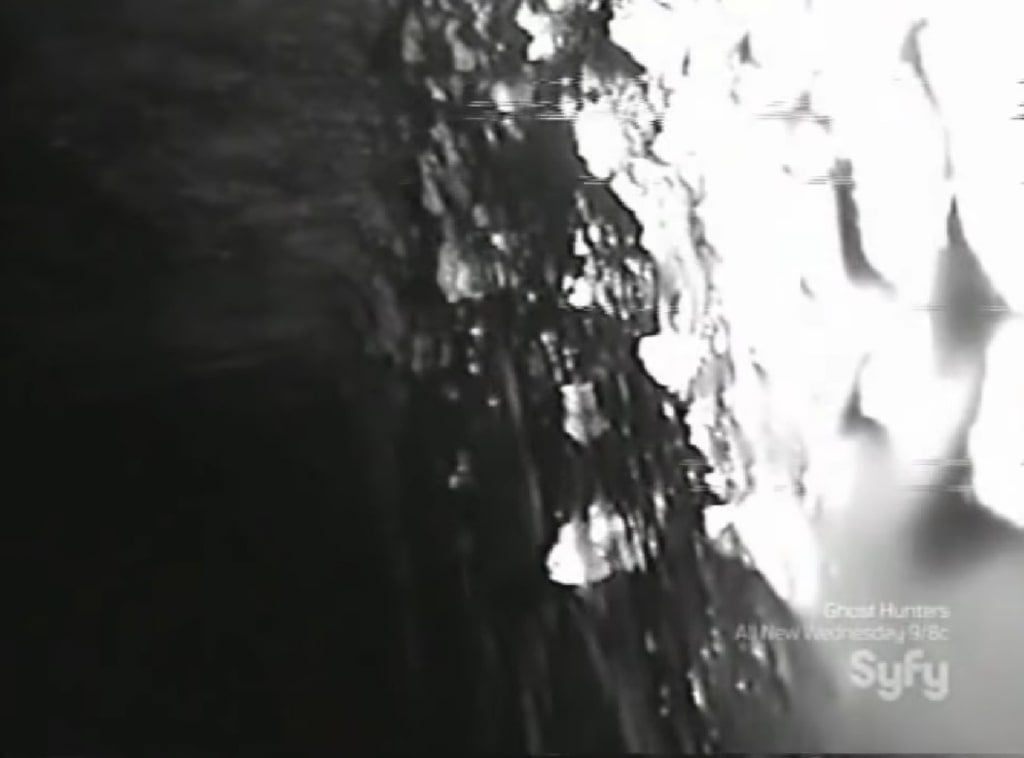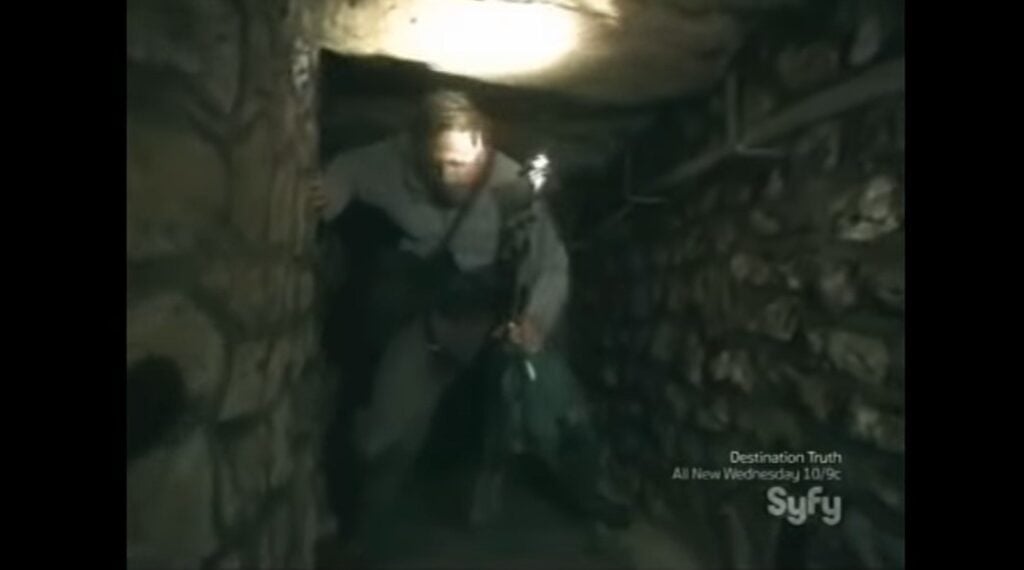Previously: Gef The Talking Mongoose.
A quick Google search is all it takes to find it: Alleged video footage of a man who disappeared in the Paris Catacombs in France in the early 1990s. It’s not a long video — just about a minute and a half on its own, although there might be more to see, depending on the context in which you find it — and what it shows is by no means graphic; indeed, taken alone, it’s hardly unsettling, let alone frightening. The uneasiness kicks in when you remember the story connected to the footage — that it purports to show a man’s final moments, and that the man who filmed it was allegedly never seen again.

But, then again… it hasn’t been determined whether or not the footage is authentic.
It hasn’t even been determined whether or not the alleged disappearance is authentic.
The Bones Of History
The Paris Catacombs are spooky enough on their own, even without a potentially unsolved disappearance to take into account; ossuaries, cemeteries, and other places that house the remains of the dead tend to have that kind of effect on us. What’s sort of interesting, though, is that the Catacombs were originally built for an imminently practical purpose: They were meant to solve a public health crisis.
[Like what you read? Check out Dangerous Games To Play In The Dark, available from Chronicle Books now!]
Paris’ history is vast — the oldest evidence we have of human habitation of the area dates back to 8000 BCE — which, as you might imagine, has resulted in a lot of dead people over the millennia. Indeed, according to Smithsonian Magazine, so many Parisians had died by the 17th century that the cemeteries were literally overflowing with bodies. This, in turn, led to the rampant spread of disease (not to mention a pervasive smell of rot — and you can imagine what happened when it rained heavily, right?) — so in 1786, the decision was made to empty the cemeteries and transfer the remains of the city’s dead into the tunnels that existed below the streets of Paris. The tunnels had been created from the mining of limestone quarries centuries before; they were perfect, pre-built catacombs. Over the course of 12 years, the bodies of six to seven million people were moved to what would become known as the Catacombs of Paris.
Naturally, the Catacombs subsequently gained a reputation for being haunted. That’s a lot of dead people, after all.

The tunnels that make up the Catacombs wend their way through the subterranean depths of Paris for more 200 miles — and every one of those miles is lined with the bones of long-dead Parisians. To give you a general idea of the total distance covered by the Paris Catacombs, it’s about the length of a trip by car between New York and Boston. And given how twisting, turning, and downright dark those tunnels are, it’s perhaps inevitable that, over the centuries, a few living folks would get lost down there among the dead. Indeed, one of these lost souls serves as the inspiration for the most enduring ghost story connected to the Catacombs: The disappearance and subsequent death of Philibert Aspairt.
Early in the Catacombs’ life as an underground ossuary, Aspairt, a doorkeeper and porter for the Val-de-Grâce hospital, ventured down into the Catacombs through a staircase accessible from the hospital’s courtyard… and was never seen alive again. His body was discovered in 1804, at which point he “had been missing from his house for 10 or 12 years,” according to his death certificate — which means his disappearance occurred somewhere between 1902 and 1904. In a cruel twist of fate, his remains were found only a few feet from an exit; he was so close to getting out, and yet he just didn’t make it.
Perhaps that’s why many believe that he’s still down there. In one way, he actually his; his tomb is located deep within the catacombs underneath rue Henri Barbusse, in an area that’s restricted to the public. But according to some, his ghost wanders freely throughout the tunnels even now. He’s said to protect those who venture into the Catacombs — although from what they might need protecting, most fear to say.
More recently — and less spookily, although no less frighteningly — two teenagers spent three days lost within the Catacombs in 2017 before being found on June 14. They’re fine now, but they were taken to the hospital and treated for hypothermia. It’s unknown how they got in there; with the exception of the roughly mile and a quarter of the tunnels that are officially open to the public (in which, it should be noted, no one has ever gotten lost, as an operator of the Catacombs Museum told the Guardian in the aftermath of the story), it’s been illegal to enter the Catacombs since 1955. Entrances and exits to the tunnels are regularly tracked down and boarded up, making it increasingly difficult to find your way into the restricted areas of the Catacombs.
That, however, has not stopped the truly dedicated from seeking out the dwindling number of open entrances. Known as “cataphiles,” these brave souls might enter the Catacombs for a variety of reasons, ranging from throwing clandestine parties to simply wanting to explore — and in the early ‘90s, one such explorer allegedly lost their way, leaving only a discarded camera with some unsettling footage behind.
Lost Footage, Found

The black-and-white footage was shot with a camcorder (likely an 8 mm device using a video cassette; digital camcorders weren’t released until later in the ‘90s); consisting entirely of point-of-view shots, it’s largely unremarkable until the final few minutes. There, it goes from simple views of tunnels and bones to something… more.
First, the explorer begins to walk faster.
Then, he begins running.
His breathing intensifies as he runs.
He’s scared.
The point-of-view shot becomes disorienting as he runs, swinging from tunnel to tunnel, seeming to reflect his confusion about which one he should run down next.
Is something chasing him?
We don’t know. If there is, we don’t see it.
Then — finally — the camera simply drops to the ground. It lands in a puddle on its side… and there it stays. It films the man’s feet running away, leaving the camera — which has also been his only source of light throughout his ordeal — alone; then it continues to film until the cassette runs out of tape.
The camera was allegedly found in one of the deepest areas of the Catacombs by other explorers some years later — but the man who brought it down there was nowhere to be found.
We’ve never identified the man. We’ve never found his remains, either.
We have no idea what happened to him.
The timeline is equally hazy. Most sources identify the disappearance as having occurred in the early ’90s, but don’t identify a specific year. According to the podcast Haunted Places, however, it occurred in 1993. (But it’s also worth noting that Haunted Places always presents its stories as real, even when they may not be. While the podcast’s historical research is consistently solid, many of the spookier aspects of the episodes come from hearsay and urban legends — all of which is to say that I was unable to discover from where they got the year 1993.) The footage was then found some years later — and as far as I know, the first time it was ever shown to the public was on Oct. 24, 2000. That’s when it aired as part of a segment about the Paris Catacombs on the television program Scariest Places On Earth, which aired first on the Fox Family network before later appearing on ABC Family (now known as Freeform), SyFy, and various other cable channels.
It’s this segment that’s passed around as proof of the footage’s existence; it doesn’t appear to be available in any other format. The voice you hear in it is that of Francis Freedland, the documentary filmmaker featured on the Scariest Places On Earth episode who investigated the footage. According to Freedland, he acquired the video directly from the cataphiles who allegedly recovered the camcorder — and when he ventured into the Catacombs himself during the Scariest Places episode, he and his team seemingly found a section of the tunnels that may have appeared in the alleged missing man’s video.
It’s certainly an engaging story, and the footage that accompanies it is quite eerie, indeed. Trouble is, it might not be real — despite the decades those involved with it have spent insisting that it is. That’s the real mystery: Not how the man disappeared, but whether he disappeared at all.
Truth vs. Fiction

On the “Yes, it’s real; this guy really did disappear in the Catacombs” side of things, the story and footage do have a few things going for them. First, as YouTuber Rob Dyke observed in his 2015 analysis of the video, in all the years that have passed since the Scariest Places On Earth episode aired, not one person who could have been involved in a potential hoax has stepped forward to come clean about it. That’s pretty remarkable; at this point, it’s been nearly two decades.
And second, even if the man wasn’t being chased by a ghoulie, ghostie, or long-legged beastie, there are plenty of non-paranormal explanations for why he may have suddenly lost his cool and run off into the darkness. Remember the Dyatlov Pass incident? We can explain that now (it was probably the result of severe hypothermia) — and I think the same is true of the alleged lost explorer’s behavior at the end of the video.
Research has found that disoriented people really do walk around in circles without meaning to, while isolation — particularly in the dark — can boost our anxiety, cause our mental performance to drop, and even prompt hallucinations. One study on sensory deprivation and isolation conducted in the 1950s was meant to last six weeks — but famously, its participants ended up being able to stand the conditions for only a few days, thereby ending the experiment much sooner than anticipated. We don’t know anything about how long the alleged missing man was down there in the catacombs, but we do know that the conditions he would have been in would have started to mess with his perception of reality after a while, which could account for some of the weirder things in the video: He may have had isolation-induced anxiety; he may have been disoriented; and he may have hallucinated something chasing him.
I have questions, though — lots of them — and when I started asking them, the story began to crumble under scrutiny.
Many of my questions have to do with the source of the footage. First, who exactly are the cataphiles that found it? I don’t believe they’ve ever been identified publicly; all we have to go on is Freedland’s word that someone else found it and brought it to him. I’m not necessarily saying that he’s lying, but it would be nice to be able to verify the source of the video — and we can’t do that if we don’t know who found it. Second, did Freedland bring the footage to the police? And if he didn’t, why the hell not? I mean, sure, as a documentary filmmaker, he’d likely always be looking for the next big story to chase down; ethically, though, if you find something while investigating that indicates that someone’s life is in danger, or which could help solve a missing persons case, the right thing to do is bring it to the police, not sit on it and then debut it during a sensationalist paranormal television program.

Even if it’s possible that the lost explorer is an actor, though, for what it’s worth, Freedland himself does appear to be a real person. There isn’t a ton of information available about him online, and what little there is remains difficult to verify — but it’s there if you look. For example, I dug up a WorldCat entry pegged to the name “Francis Freedland” which does, in fact, identify him as a documentary filmmaker; what’s more, at least one of the few films listed under his name in the entry checks out: A mention of Red Squad, including Freedland’s name, appeared in the New York Times in 1972. None of these sources had a photograph of Freedland, though, so I can’t verify whether the guy in the Scariest Places episode and the guy in the WorldCat entry and New York Times article are the same guy.
Zak Bagans of the Travel Channel’s Ghost Adventures, however, did met up with Freedland in a special episode, “Netherworld,” which aired in 2014. Footage of Bagans’ interview with Freedland offers visual confirmation that it’s the same man from the Scariest Places On Earth episode, albeit about a decade and a half older. But there isn’t much in this interview that we didn’t already know; Freedland reiterated that he was never able to identify the missing man, and he didn’t know what happened to him. What’s more, Bagans wasn’t able to re-examine the area of the Catacombs Freedland did, so we can’t really confirm where in the tunnels Freedland’s initial exploration went. When Bagans asks if Freedland will take him to the location of the catacombs he had explored in the Scariest Places episode, Freedland says he will “never, never, never go back into the catacombs,” adding vehemently, “I refuse to go back down there.” He’s convincing, but it’s… a little convenient.
(Lazar Kuntsmann, the cataphile Freedland taps to lead him and his team into the Catacombs, is definitely real; he’s a major player in the “new French hacker-artist underground,” as Wired put it in 2012, and a frequent mouthpiece for the organization les UX. So, y’know, at least there’s that.)
And then there’s the exploration led by Freedland seen in the Scariest Places episode. It feels a little too pat to me, although I suppose that this could be more a symptom of the editing of the program than something that’s necessarily connected the authenticity of the expedition. At one point, though, the manhole the expedition group had intended to exit the Catacombs via turns out to be blocked, leaving them faced with backtracking the five or six miles they’d already traveled, all while suffering exhaustion and dealing with concern that their flashlights are running out of juice. To me, this parallels the experience of the “lost man” a bit too closely; it feels less like coincidence and more like something that’s been manufactured for effect.
More than that, though, I have to wonder about the conditions of the exploration in the first place: We know that entering these parts of the catacombs is illegal. Would a major American television network really be okay with following and filming a group of people engaging in explicitly illegal activity? Doing so might put the network in the way of legal liability — which, generally, is something most television networks are eager to avoid.
The bigger picture isn’t any more reassuring. In fact, the sole source of information about both the footage specifically and the overall story of the alleged missing man appears to be this single episode of Scariest Places On Earth — and that’s… weird. I haven’t been able to dig up any archived news coverage from legitimate sources from the early ‘90s about the disappearance, or any from the late ‘90s or early ‘00s about the recovery of the camera — either in English on Google’s American site or in French on Google’s French site. Granted, there’s a language and culture barrier here; my French is very, very rusty, and I’m not terribly familiar with French news media. Still, though — most major global newspapers have digitized their archives by now, so if there were anything there to find about this story from the time it occurred, it would be relatively easy to locate. And you’d think a missing person in the Paris Catacombs would be a pretty big story, no? There aren’t even any mentions of the alleged disappearance in the coverage of the teens who went missing in 2017. This also strikes me as odd, given that it’s common practice for journalists to put stories in context by discussing other historically relevant events alongside the current one.
The complete footage — anything beyond the minute and a half that appears in Scariest Places and was subsequently used in the Ghost Adventures special and other similar shows — does not appear ever to have been released to the public in full.

The lack of information about this story outside of Scariest Places On Earth is worth noting when you consider the fact that the show has been criticized a number of times for oversimplifying, embellishing, or shaping episodes’ narratives in ways that may be considered slightly misleading. For example, after the airing of the first episode of the series, which featured a segment on the Villisca Axe Murder House, the makers of the documentary Villisca: Living With A Mystery called the show out for its overly-dramatic recreations of historical events and oversimplification of some of the details of the case; then, when Scariest Places went to the Pine Barrens in New Jersey — a segment which aired during the same episode as the one featuring the Paris Catacombs — the Jersey Devil research group that worked with the show, the Devil Hunters, were less than flattering in their account of the filming of the episode. (Triage Entertainment, which produced Scariest Places, does not appear to have ever responded to these criticisms.)
Don’t get me wrong: I ate up Scariest Places On Earth when it was airing; the only kind of reality TV I even remotely enjoy is the ghost-hunting variety. It’s enormously entertaining — but I think that’s the key here: It’s entertainment. And, as we’ve seen time and time again, nothing makes a good spooky story more entertaining than blurring the line between fact and fiction. If that’s what’s going on here — if this whole story about a missing man and his last recorded moments is a fabrication told for entertainment — well… I’d say the tale’s unexpected endurance is a testament to how effective this kind of storytelling can be.
But Still…
But even if I come down on the side of thinking the whole alleged disappearance is nothing but a hoax, the bottom line is this: We still don’t know if it really is. And I don’t know if we ever really will. As far-fetched as I find most of the situation, it’s not impossible that someone could have gone down there without telling anyone else. It’s not impossible that someone could get lost under there and never be found. It’s not impossible that a person reported missing might never be connected with an ancient underground ossuary.
It’s not impossible that it could be real.
And that’s perhaps the scariest thing of all.
***
Follow The Ghost In My Machine on Bluesky @GhostMachine13.bsky.social, Twitter @GhostMachine13, and Facebook @TheGhostInMyMachine. And for more games, don’t forget to check out Dangerous Games To Play In The Dark, available now from Chronicle Books!
[Photos via tdfugere, chiefhardy, skeeze/Pixabay; creepypaste/YouTube]